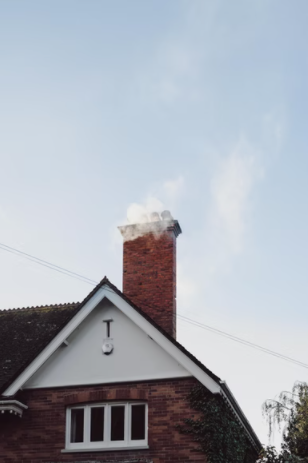Let’s face it: chimneys are not something that tends to occupy the proverbial forefront of our minds. They sit atop our homes, inconspicuous and silent. And, unlike a knocking car engine or leaking window, they rarely announce so adamantly their need of clearing or repair, despite the very real dangers that can accompany a poorly maintained chimney.
In fact, a chimney in disrepair can easily become a fire hazard and catalyst for the spread of poisonous carbon monoxide gas in your home. Another matter worth considering is that chimney malfunction can lead to higher energy costs. In short, inconspicuous as they may be, chimneys are worth a second thought!
That’s why the experts at Davidoff Roofing want to guide you through the “ins and outs” of proper chimney maintenance.
Why Is It Important to Maintain My Chimney?
Chimney maintenance is a crucial part of regular maintenance to your home.
1. Soot & Creosote Build-Up
If you burn wood, you will need to have your chimney’s flue inspected for the build-up of soot and creosote. Creosote is a tar-like, carbon-based substance that often accumulates on the interior walls or “lining” of chimney flues as the result of the inefficient combustion of materials in a fireplace or woodstove. As little as 1/8 of an inch of creosote build-up can hinder the proper flow of smoke and gases from your fireplace out the chimney. It’s a good idea to have your chimney inspected for creosote build-up at least once per year.
2. Crumbling Chase Joints
If the exterior wall or “chase” of your chimney consists of bricks, it is important to have the mortar joints inspected for deterioration. Crumbling chase joints and old, malfunctioning flashing around the chimney’s base both can allow water into the interior of your attic and home, leading to rot, mildew and other kinds of moisture damage.
3. Flue Cap, Screen, and Crown
Finally, the flue cap, screen and crown (all at the top of the chimney) should be maintained so as to prevent sparks from escaping the flue pipe and rodents and other pests from entering and nesting within it.
What Are the Types of Chimneys?
Traditional chimneys are made of brick and mortar. However, newer chimneys can be composed of metal or even prefabricated materials designed to look like the classical brick-and-mortar variety. Stoves and certain kinds of fireplaces can also have their own freestanding chimney pipes that tie into existing chimneys or metal stacks on the home’s exterior.
How Often Should You Clean Your Chimney?
For the reasons mentioned above, it’s a good idea to inspect and (if necessary) service your chimney once per year – or have the work done by a professional. A roofing and chimney expert will search for signs that your chimney might not be functioning at its optimal level or might be letting undesirable elements into your home.
How Do You Maintain a Chimney?
Even without calling on a chimney technician for help, there are important steps homeowners can take to maintain their fireplaces and chimneys so as to prevent the hazards of fire and carbon monoxide from smoke.
If you feel comfortable on a ladder and rooftop, you can inspect your own chimney for signs of potential leaks (i.e. crumbling mortar and bricks, flashing pulling away from the chimney sides, etc.) or other possible hazards. Keep combustible objects such as tree limbs clear of the chimney. (It’s a good idea to allow for at least 15 feet of clearance above the stack.) Shine a light inside the chimney flue to search for signs of soot and creosote build-up, too.
You can maintain your fireplace by cleaning out the ash box regularly and ensuring that the dampers are in good working order. Believe it or not, your combustion fuels also make a difference. Try to burn mostly well-seasoned hardwoods to minimize build-up in your chimney system.
Have you noticed your chimney is in need of a checkup? Contact the experts at Davidoff Roofing today to learn more about our chimney repair service.
